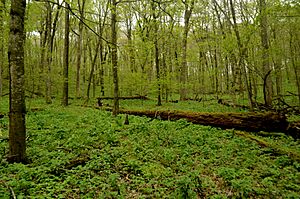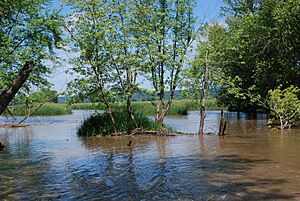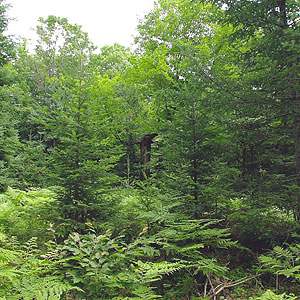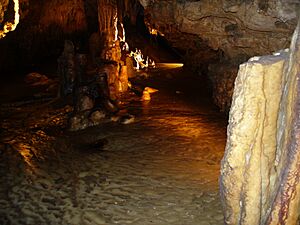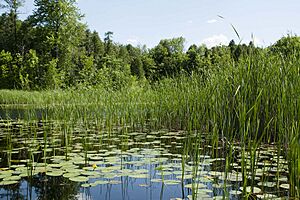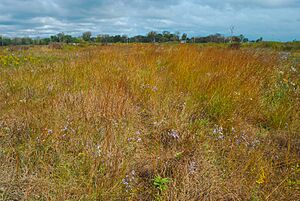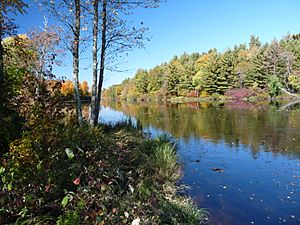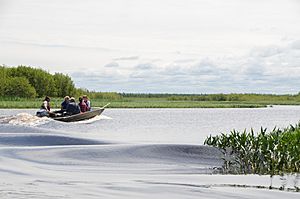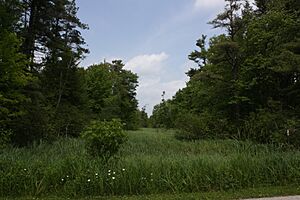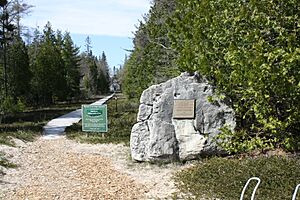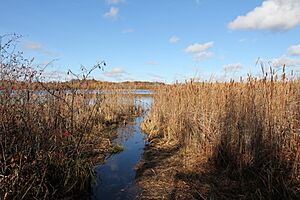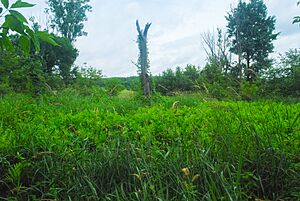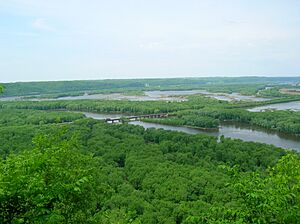List of National Natural Landmarks in Wisconsin facts for kids
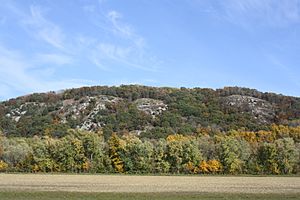
Did you know that Wisconsin has some really special natural places? These places are called National Natural Landmarks (NNLs). They are like nature's treasures! There are 18 of these landmarks in Wisconsin. They are part of almost 600 such places across the United States.
These landmarks protect important natural areas. They can be unique landforms, special forests, or homes for rare plants and animals. Some are sand dunes, swamps, or very old forests. Many of these spots help protect plants and animals that are hard to find elsewhere. The Driftless Area in southwest Wisconsin is especially famous for its rare species. The Baraboo Range is a great example.
These special places are owned by different groups. Some are owned by individuals or Native American tribes. Others are managed by state or federal agencies. These landmarks were chosen between 1967 and 1987. They range in size from small (about 44 acres) to very large (over 53,000 acres).
Contents
- What are National Natural Landmarks?
- Wisconsin's Natural Treasures
- Abraham's Woods
- Avoca River-Bottom Prairie
- Baraboo Range
- Bose Lake Hemlock Hardwoods
- Cave of the Mounds
- Cedarburg Bog
- Chippewa River Bottoms
- Chiwaukee Prairie
- Finnerud Forest Scientific Area
- Flambeau River Hemlock-Hardwood Forest
- Kakagon Sloughs
- Kickapoo River Natural Area
- Moquah Barrens Research Natural Area
- Point Beach Ridges
- The Ridges Sanctuary
- Spruce Lake Bog
- Summerton Bog
- Wyalusing Hardwood Forest
What are National Natural Landmarks?
The National Natural Landmarks Program helps protect America's natural heritage. The National Park Service runs this program. This is a part of the Department of the Interior. They decide which places are important enough to be NNLs.
First, they check if a place meets certain rules. Then, they tell the owners about the idea. The Secretary of the Interior makes the final decision. Both public and private lands can become NNLs. Owners can say no if they don't want their land to be a landmark. Being an NNL helps protect these places. It can offer tax benefits or grants to help care for the land.
Wisconsin's Natural Treasures
Wisconsin is home to 18 amazing National Natural Landmarks. Each one is special for different reasons. Let's explore some of them!
Abraham's Woods
Designated in 1973, Abraham's Woods is in Green County. It is 44 acres. This landmark protects a beautiful old forest. It is a great example of a maple and basswood forest.
Avoca River-Bottom Prairie
Chosen in 1980, Avoca River-Bottom Prairie is in Iowa County. It covers 762 acres. This is the biggest natural prairie left in Wisconsin. Prairies are grasslands with many different plants.
Baraboo Range
The Baraboo Range became a landmark in 1980. It is located in Columbia and Sauk counties. This huge area is 53,531 acres. It is an ancient mountain range that has been uncovered by nature.
Bose Lake Hemlock Hardwoods
This landmark was designated in 1980. It is in Forest County and is 62 acres. It has the best untouched hemlock forest in Wisconsin. It is part of the Chequamegon-Nicolet National Forest.
Cave of the Mounds
Designated in 1987, Cave of the Mounds is in Dane County. It is 63 acres. This cave is famous for its many different and beautiful cave formations.
Cedarburg Bog
The Cedarburg Bog became a landmark in 1973. It is in Ozaukee County and is 2,817 acres. This is the largest and most important bog in southeastern Wisconsin. Bogs are wetlands with special plants.
Chippewa River Bottoms
The Chippewa River Bottoms was chosen in 1973. It is in Buffalo County and is 8,086 acres. This area has the largest forest of hardwood trees along a river. These forests grew after the last ice age.
Chiwaukee Prairie
Designated in 1973, Chiwaukee Prairie is in Kenosha County. It is 485 acres. This is the best wet prairie left in Wisconsin. It is located along the shore of Lake Michigan.
Finnerud Forest Scientific Area
The Finnerud Forest Scientific Area became a landmark in 1973. It is in Oneida County and is 117 acres. This forest is a great example of a northern forest with evergreen trees.
Flambeau River Hemlock-Hardwood Forest
Chosen in 1973, this forest is part of the Flambeau River State Forest. It is in Price and Sawyer counties. It is 391 acres. This is the largest and best old-growth forest in Wisconsin with both evergreen and hardwood trees.
Kakagon Sloughs
The Kakagon Sloughs was designated in 1973. It is in Ashland County and is 2,932 acres. This is one of the best marsh areas on the upper Great Lakes. It is owned by the Bad River Tribe.
Kickapoo River Natural Area
The Kickapoo River Natural Area became a landmark in 1975. It is in Vernon County and is 5,841 acres. This area has the largest amount of exposed sandstone in Wisconsin. It also has unique plants and winding river paths typical of the Driftless Area.
Moquah Barrens Research Natural Area
Designated in 1980, Moquah Barrens Research Natural Area is in Bayfield County. It is 632 acres. This area shows what the jack pine and scrub oak savannas looked like. It is found in the Chequamegon National Forest.
Point Beach Ridges
The Point Beach Ridges was chosen in 1980. It is in Manitowoc County and is 151 acres. This landmark has alternating sand ridges and low wet areas. These were formed by old water levels of Lake Michigan.
The Ridges Sanctuary
The Ridges Sanctuary was one of the first landmarks, designated in 1967. It is in Door County and is 2,281 acres. It has a series of sand ridges and wet areas. It also has northern forests and bog plants.
Spruce Lake Bog
Spruce Lake Bog was also designated in 1967. It is in Fond du Lac County and is 162 acres. This is a wonderful example of a northern bog that has not been disturbed.
Summerton Bog
The Summerton Bog became a landmark in 1973. It is in Marquette County and is 266 acres. This bog is untouched and has many different kinds of plants. It is home to many rare plant and animal species.
Wyalusing Hardwood Forest
Designated in 1973, Wyalusing Hardwood Forest is in Grant County. It is 214 acres. This forest has several rare plant species. It also has lots of wildlife, including some endangered animals.


